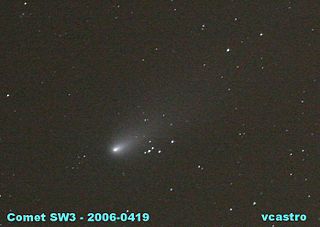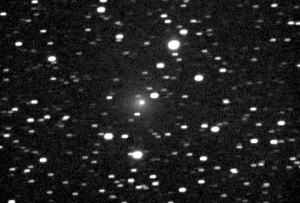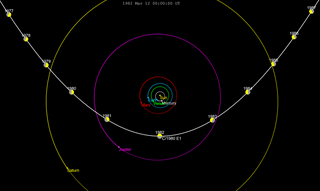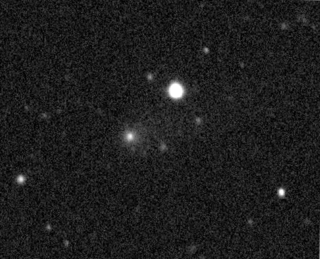
An apsis is the farthest or nearest point in the orbit of a planetary body about its primary body. The line of apsides is the line connecting the two extreme values.

12P/Pons–Brooks is a periodic comet with an orbital period of 71 years. It fits the classical definition of a Halley-type comet with an orbital period between 20 and 200 years, and is also one of the brightest known periodic comets, reaching an absolute visual magnitude ~5 in its approach to perihelion. Comet Pons-Brooks was discovered at Marseilles Observatory in July 1812 by Jean-Louis Pons, and then later recovered in 1883 by William Robert Brooks.

Tempel 1 is a periodic Jupiter-family comet discovered by Wilhelm Tempel in 1867. It completes an orbit of the Sun every 5.6 years. Tempel 1 was the target of the Deep Impact space mission, which photographed a deliberate high-speed impact upon the comet in 2005. It was re-visited by the Stardust spacecraft on February 14, 2011, and came back to perihelion in August 2016. On 26 May 2024, it will make a modest approach of 0.55 AU to Jupiter which will lift the perihelion distance and 9P will next come to perihelion on 12 February 2028 when it will be 1.77 AU from the Sun.

Comet 4P/Faye is a periodic Jupiter-family comet discovered in November 1843 by Hervé Faye at the Royal Observatory in Paris. Its most recent perihelia were on November 15, 2006; May 29, 2014; and September 8, 2021.

10P/Tempel, also known as Tempel 2, is a periodic Jupiter-family comet with a 5 year orbital period. It was discovered on July 4, 1873 by Wilhelm Tempel. The next perihelion passage is 2 August 2026 when the comet will have a solar elongation of 164 degrees at approximately apparent magnitude 8. Closest approach to Earth will be one day later on 3 August 2026 at a distance of 0.414 AU (61.9 million km).
39P/Oterma is a currently inactive periodic comet with an orbital period of nearly 20 years that stays outside the orbit of Jupiter. The nucleus has a diameter around 4–5 km. It was last observed in August 2021 and came to perihelion in July 2023 while 1.2 AU from Jupiter. It will finish the modest approach to Jupiter in January 2025 and will next come to perihelion in July 2042 at distance of 5.9 AU from the Sun. Opposition has occurred on 11 November 2023.

73P/Schwassmann–Wachmann, also known as Schwassmann–Wachmann 3 or SW3 for short, is a periodic comet that has a 5.4 year orbital period and that has been actively disintegrating since 1995. When it came to perihelion in March 2017, fragment 73P-BT was separating from the main fragment 73P-C. Fragments 73P-BU and 73P-BV were detected in July 2022. The main comet came to perihelion on 25 August 2022, when the comet was 0.97 AU from the Sun and 1 AU from Earth. It will be less than 80 degrees from the Sun from 25 May 2022 until August 2023. On 3 April 2025 it will make a modest approach of 0.3 AU to Jupiter. 73P will next come to perihelion on 23 December 2027 when it will be 0.92 AU from the Sun and on the far side of the Sun 1.9 AU from Earth.

7P/Pons–Winnecke is a periodic Jupiter-family comet with a six-year orbit. Early calculations for the 1921 apparition suggested that the orbit of the comet might collide with Earth in June, but observations on 10 April ruled out an impact. It made a very close approach to Earth in June 1927. The outward migration of perihelion created impressive meteor showers in 1916, 1921 and 1927.

11P/Tempel–Swift–LINEAR is a periodic Jupiter-family comet in the Solar System.

Comet Finlay is a periodic comet with an orbital period of 6 years discovered by William Henry Finlay on September 26, 1886. The next perihelion passage is July 13, 2021 when the comet will have a solar elongation of 54 degrees at approximately apparent magnitude 10. It last came to perihelion on December 27, 2014, at around magnitude 10. Of the numbered periodic comets, the orbit of 15P/Finlay has one of the smallest minimum orbit intersection distances with the orbit of Earth (E-MOID). In October 2060 the comet will pass about 5 million km from Earth.
Comet 177P/Barnard, also known as Barnard 2, is a periodic comet with an orbital period of 122 years. It fits the classical definition of a Halley-type comet with. It orbits near the ecliptic plane and has aphelion near the Kuiper cliff at 48 AU (7.2 billion km).

Comet Kopff or 22P/Kopff is a periodic comet in the Solar System. Discovered on August 23, 1906, it was named after August Kopff who discovered the comet. The comet was missed on its November 1912 return, but was recovered on its June 1919 return and has been seen at every apparition since. Close approaches to Jupiter in 1938 and 1943 decreased the perihelion distance and orbital period. 22P/Kopff’s last perihelion passage was 18 March 2022. On 13 July 2028 it will pass 0.353 AU (52.8 million km) from Earth.

Comet Schaumasse is a periodic comet discovered by Alexandre Schaumasse on 1 December 1911 as 12th magnitude. It next comes to perihelion on 8 January 2026 and should brighten to about magnitude 9.

C/1980 E1 is a non-periodic comet discovered by Edward L. G. Bowell on 11 February 1980 and which came closest to the Sun (perihelion) in March 1982. It is leaving the Solar System on a hyperbolic trajectory due to a close approach to Jupiter. In the 43 years since its discovery only two objects with higher eccentricities have been identified, 1I/ʻOumuamua (1.2) and 2I/Borisov (3.35).

94P/Russell 4 is a periodic comet in the Solar System. It fits the definition of an Encke-type comet with. It was discovered by Ken Rusell on photographic plates taken by M. Hawkins on March 7, 1984. In the discovery images, Russell estimated that the comet had an apparent magnitude of 13 and a noticeable tail of 5 arc minutes. In the year of discovery, the comet had come to perihelion in January 1984.
82P/Gehrels is a periodic comet that was discovered on October 27, 1975, by Tom Gehrels at the Palomar Mountain Observatory in California having a faint nuclear brightness of magnitude 17.
C/2000 W1 (Utsunomiya–Jones) is a long-period comet from the Oort cloud discovered on November 18, 2000, by Syogo Utsunomiya and Albert F. A. L. Jones. The comet reached up to apparent magnitude 5.5, but was only 27 degrees from the Sun in mid-December 2000.

70P/Kojima is a periodic comet in the Solar System with a current orbital period of 7.05 years.

104P/Kowal, also known as Kowal 2, is a periodic Jupiter-family comet discovered by Charles T. Kowal in 1979. The orbit was confirmed after new sightings in 1991 and 1998.

C/2023 P1 (Nishimura) is a long-period comet discovered by Hideo Nishimura on 12 August 2023. The comet passed perihelion on 17 September 2023 and reached an apparent magnitude of about 2.5.


















